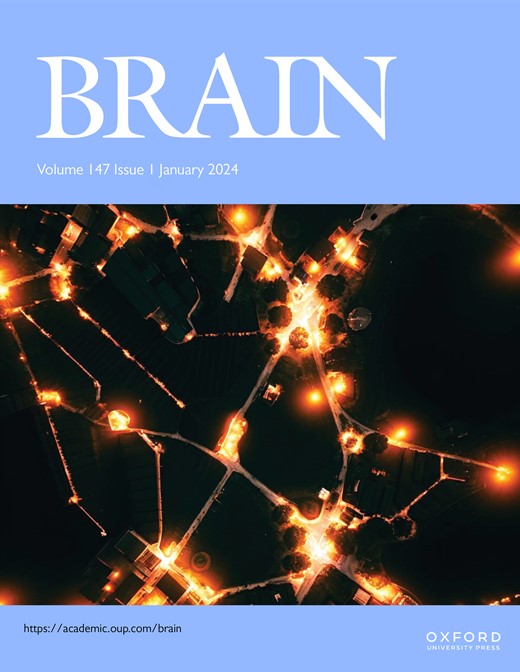EIPR1 variants cause a neurodevelopmental disorder with endolysosomal and dense core vesicle defects.
IF 11.7
1区 医学
Q1 CLINICAL NEUROLOGY
引用次数: 0
Abstract
EIPR1 (EARP-interacting protein 1, formerly known as TSSC1) is a WD40-domain protein that interacts with the EARP (endosome-associated recycling protein) and GARP (Golgi-associated retrograde protein) complexes in the process of delivering endosome-derived transmembrane cargos to the plasma membrane and the trans-Golgi network (TGN), respectively. Additionally, EIPR1 cooperates with EARP in the biogenesis of dense core vesicles. While these properties of EIPR1 were established in cultured cells and model organisms, the physiological and pathological importance of EIPR1 in humans remains to be determined. Here we report the identification of five EIPR1 homozygous missense variants [NM_003310.5:c.835C>G p.(Arg279Gly), NM_003310.5:c.813C>G p.(His271Gln), NM_003310.5:c.694C>T p.(Arg232Trp), NM_003310.5:c.47G>A p.(Arg16His) and NM_003310.5:c.419T>A p.(Val140Asp)] in eight individuals from six unrelated families with a neurological disorder featuring a spectrum of global neurodevelopmental delay, microcephaly, ataxia, spasticity, delayed myelination, callosal hypoplasia, cerebellar atrophy, walking and speech impairments, dysmorphic facies, and neutropenia. Cellular studies using a heterologous transfection system demonstrate that these variants reduce EIPR1 protein levels and its physical interaction with EARP and GARP complexes. Furthermore, we show that the Arg279Gly and His271Gln variants reduce the ability of EIPR1 to promote EARP association with endosomes in non-neuronal cells and dense core vesicle biogenesis in iPSC-derived neurons. Additionally, skin fibroblasts from one of the Arg279Gly affected individuals shows reduced recycling of internalized transferrin to the plasma membrane (an EARP-deficiency phenotype) and impaired retrograde transport of internalized Shiga toxin B-subunit to the TGN (a GARP-deficiency phenotype) compared to fibroblasts from an unaffected parent. Moreover, these patient fibroblasts exhibit enlarged lysosomes, increased levels of the lysosomal membrane protein LAMP1, and increased levels of the autophagic markers LC3B-II and SQSTM1, all phenotypes previously associated with GARP deficiency. Knockout of the orthologous eipr1 in zebrafish results in neurodevelopmental and locomotor defects consistent with the clinical phenotype of the human patients. Injection of WT human EIPR1 mRNA into eipr1 KO zebrafish rescues these defects, whereas mRNAs encoding the human EIPR1 variants Arg279Gly or His271Gln fail to do so, confirming the impaired activity of these variants. These findings identify EIPR1 as a novel genetic locus associated with a neurodevelopmental disorder and underscore its critical role in endosomal recycling and dense core vesicle biogenesis, processes essential for the development and function of the nervous system.EIPR1变异引起神经发育障碍,伴有内溶酶体和致密核心囊泡缺陷。
EIPR1 (EARP- interaction protein 1,以前称为TSSC1)是一种wd40结构域蛋白,在将内体衍生的跨膜货物传递到质膜和反式高尔基网络(TGN)的过程中,它分别与EARP(内体相关循环蛋白)和GARP(高尔基相关逆行蛋白)复合物相互作用。此外,EIPR1在致密核囊泡的生物发生中与EARP合作。虽然EIPR1的这些特性已经在培养细胞和模式生物中确立,但EIPR1在人类中的生理和病理重要性仍有待确定。本文报道了5个EIPR1纯合错义变异[NM_003310.5:c]。835C>G p.(Arg279Gly), NM_003310.5:c。813C>G p.(His271Gln), NM_003310.5;694C>T p.(Arg232Trp), NM_003310.5:c。47G>A p.(Arg16His)和NM_003310.5:c。[19]研究了来自6个不相关家族的8名神经系统疾病患者,这些患者表现为整体神经发育迟缓、小头畸形、共济失调、痉挛、延迟髓鞘形成、胼胝体发育不全、小脑萎缩、行走和语言障碍、畸形相和中性粒细胞减少。使用异源转染系统的细胞研究表明,这些变异降低了EIPR1蛋白水平及其与EARP和GARP复合物的物理相互作用。此外,我们发现Arg279Gly和His271Gln变异体降低了EIPR1促进EARP与非神经元细胞内体结合的能力,以及ipsc衍生神经元中致密核心囊泡生物发生的能力。此外,与未受影响的亲本成纤维细胞相比,来自Arg279Gly感染个体的皮肤成纤维细胞显示内化转铁蛋白到质膜的再循环减少(earp缺乏表型),内化志嘉毒素b亚基到TGN的逆行运输受损(garp缺乏表型)。此外,这些患者成纤维细胞表现出溶酶体增大,溶酶体膜蛋白LAMP1水平升高,自噬标记物LC3B-II和SQSTM1水平升高,所有这些表型先前都与GARP缺乏相关。敲除斑马鱼中同源的eipr1导致神经发育和运动缺陷,与人类患者的临床表型一致。将WT型人类EIPR1 mRNA注射到EIPR1 KO斑马鱼中可以挽救这些缺陷,而编码人类EIPR1变体Arg279Gly或His271Gln的mRNA则无法做到这一点,这证实了这些变体的活性受损。这些发现确定了EIPR1是一个与神经发育障碍相关的新基因位点,并强调了其在内体循环和密集核心囊泡生物发生中的关键作用,这些过程对神经系统的发育和功能至关重要。
本文章由计算机程序翻译,如有差异,请以英文原文为准。
求助全文
约1分钟内获得全文
求助全文
来源期刊

Brain
医学-临床神经学
CiteScore
20.30
自引率
4.10%
发文量
458
审稿时长
3-6 weeks
期刊介绍:
Brain, a journal focused on clinical neurology and translational neuroscience, has been publishing landmark papers since 1878. The journal aims to expand its scope by including studies that shed light on disease mechanisms and conducting innovative clinical trials for brain disorders. With a wide range of topics covered, the Editorial Board represents the international readership and diverse coverage of the journal. Accepted articles are promptly posted online, typically within a few weeks of acceptance. As of 2022, Brain holds an impressive impact factor of 14.5, according to the Journal Citation Reports.
 求助内容:
求助内容: 应助结果提醒方式:
应助结果提醒方式:


